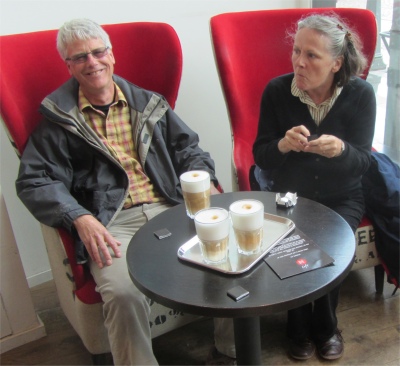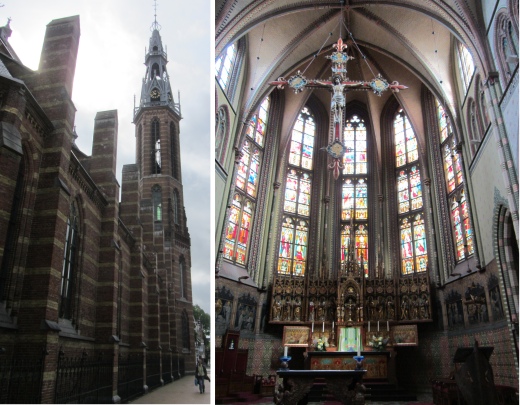
St Joseph Cathedral with the Drunk Tower
|
The city was blessed with quite a few hospices. We began by visiting the St Geertruid or Pepergasthuis, established in 1405. Sadly it was not open to the public, but undeterred we continued on to the St Anthony Gasthuis. This hospice, established in 1517, was originally located outside the city walls because it was not only for the poor, but also for plague sufferers and the mentally ill. The hospice was constructed with material from the demolished castle located at the Rademarkt. We entered the hospice though a small door in a large back wooden gate which was housed in an impressive arch. Inside, we found a beautiful rectangular garden surrounded by a continuous mix of single and double storey dwellings which might have been rooms at one time.

Chalet on Heresingel
|
Just past the hospice was St Joseph Roman Catholic Cathedral, constructed at the end of the 19th century, when the city started expanding considerably. The design is by architect P. Cuypers. Its tower has the nickname of the "drunk tower" because two clock faces are always visible. We took time out to have a look inside, Meryl admiring the stained-glass
Noticing a bridge up over the Verbindingskanaal, we went to watch a yacht heading up to the Oosterhaven, and then we strolled down Heresingel which ran parallel with the canal. Here we found magnificent houses and chalets, constructed with boulevards on the ramparts that were levelled at the end of the 19th century. The road ended at a large roundabout, the Hereplein, which contained the sculptured version of "Langs Moeders Graf" (Passing Mother's Grave), a father and his children walking past their mother's tombstone. The sculpture was by A. Hesselink based on a painting by Jozef Israels.
As I said earlier, there are quite a few hospices in this city. Heiligen Geestgasthuis was our next port of call. This hospice was founded in the 13th century by the Orde van de Heilige Geest (order of the Holy Spirit). Their identifying mark, the double St Andrew's cross, was seen in several places. This hospice took care of the poor, sick and elderly and functioned as an inn also (can't be bad). The church is still used for religious services, concerts etc. We took the liberty of having a look around inside the hospice. Of course we could not enter any of the buildings, but the layout was spectacular. Several separate garden areas, all beautifully kept, were connected by walkways and arches, it was as if we were walking through a group of private gardens, but the compound was open to the public. Yet, taking a close-up photo of a group of enamelled tea or coffee pots grouped together on the ground, I heard a tapping at a window. A chap inside made it perfectly clear that he did not want me on his personal space by his window.
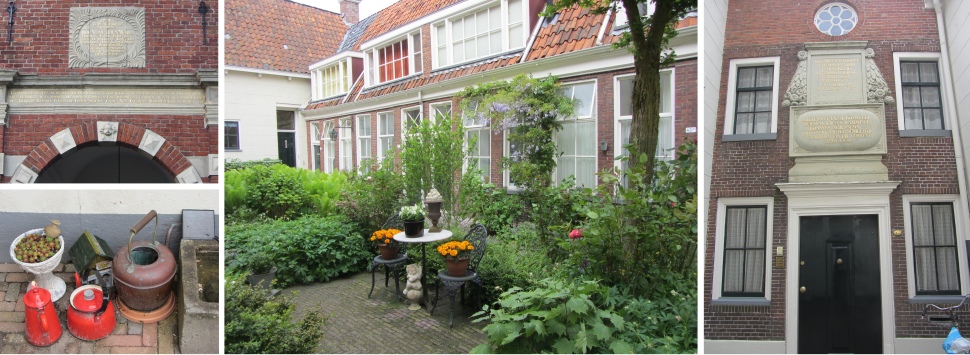
Inside Heiligen Geestgasthuis (Holy Spirit Hospice)
|
Leaving this stunning little retreat, we walked up past a Moresque style synagogue which currently had an exhibition running. Meryl was quite taken with one of the posters, so much so that she later acquired one. The synagogue stood in Folkingestraat, once the centre of the old Jewish neighbourhood, but now a busy and friendly thoroughfare with shops selling trinkets and clothing from all over the world. As the street opened out into the Vismarkt (fish market), just on our left corner lay Huis de Beurs, the city's oldest pub.
At this end of the Vismarkt (Fishmarket but , now a flower market), the Korenbeurs (Corn Exchange) stood. This Neoclassic exchange from 1865 had a facade adorned with three sculptures: Mercury (god of traders and thieves), Neptune (god of the sea and seafaring) and Ceres (the earth goddess). The particular cast iron roof construction with innumerable windows ensured perfect light incidence, essential for sampling grain. Today the exchange had a new lease of life as a supermarket, but corn is still sold every Tuesday. Philosophically, it was still an exchange, folk exchanged money for food.
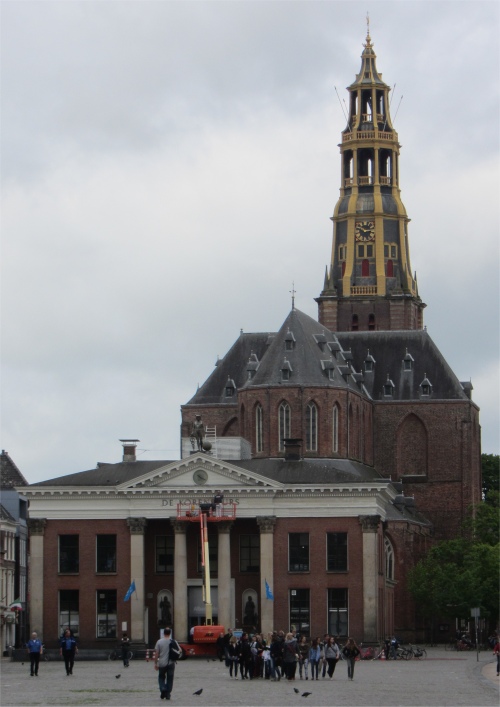
Korenbeurs (Corn Exchange) with Der Aa-kerk Church and Tower Behind
|
Directly behind the Korenbeurs proudly stood Der Aa-kerk. Located in the old harbour area, the church was dedicated to Mary and St Nicholas, patron saint of sailors, and was exalted to a parish church in 1247. The current building dates back to the 15th century. The striking tower was reconstructed in 1718, and at the northern side of the church is the Hanze House.
Heading down Brugstraat, we came across the Noordelijk Scheepvaart Museum (Northern Nautical Museum), located in an originally mediaeval Gothic merchant house. Still known as the Gothic house, the building clung on to its original facade, and once functioned as a brewery. Rex and I wandered through an arched entrance into a courtyard behind the museum, observing a tunnel that ran under the building, at one time linking the front with the courtyard. Rex and I would have loved to spend some time here, but Meryl had had enough of maritime museums in Den Helder. "Nelson and Hardy never had this trouble."

Mediaeval Gothic Merchant House, now a Nautical Museum
|
The street brought us down to another canal, which we followed up along Hoge Der A. This street, and Lage Der A on the other side of the canal, contained numerous red-brick warehouses around the old Aa harbour, that are reminiscent of the fact that Groningen was an important commercial and Hansa town in the Middle Ages. This was also the location of various breweries that produced kluinbier (Groningen beer), an important export. Most buildings have been converted into dwellings or offices. In winter, the canal functions as the mooring for ships of the "bruine vloot" (brown fleet).
Returning to reality, we sauntered through the Harmonie complex which included two university faculties, and was awash with students of course. This naturally led on to the Academiegebouw (Academy Building). In 1614, the second university in the Netherlands, the University of Groningen, was established in former monastery buildings. The current Academiegebouw was designed in Neo-renaissance style and put into use in 1990. The top facades showed various allegoric images, the whole being a stunning, tasteful building. Outside the building was one huge cycle park.
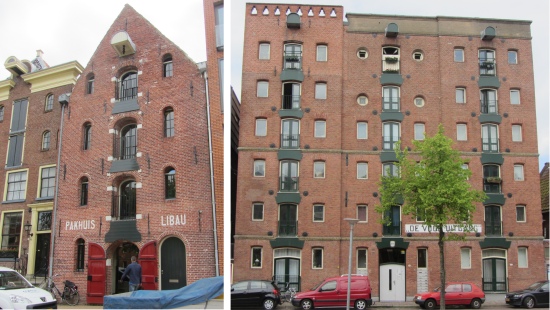
Old Warehouses on the Hoge Der A and Lage Der A
|

The Locals
|
We turned down Oude Boteringestraat, a traditionally distinguished street accommodating a number of historic buildings and places of interest. At the bottom we arrived at the Spilsluizen, a mediaeval canal and former harbour, which had an open connection to the sea until 1876. The quay is therefore on two levels, separated by the Spilsluizen, one for high tide and the other for low tide. It was along this street that we found a small hardware shop. Rex dived straight into it to ascertain whether they sold funnels. Indeed they did, and Rex bought himself the funnel of his dreams. The chatty shop-owner proudly showed us his gleaming 19th century cash-register; a work of art. Despite Rex's joy, Meryl couldn't quite grasp how he could be so passionate about a funnel. Rex's response, "It is what it is," a turn of phrase he often uses in his proceedings in his consultancy role. Another dimension, me thinks.
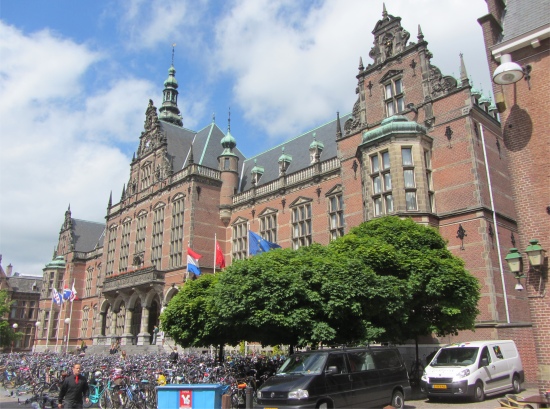
Academiegebouw (Academy Building)
|
We turned a corner, passing a former pharmacy. The businesses former signboard, which was still attached to the building, contained a carved deer head with antlers. This was a reference to grated deer horn, considered a remedy in olden days.
We passed by yet another hospice, the Vrouw Wilsoors or Aaien Olthohgasthuis. This entirely renovated hospice was established in 1766 and was intended for elderly women. In summer, lime espaliers functioned as sunblinds to ensure that residents would not suffer from the heat. This reminded us of other espaliers we had seen on our travels.
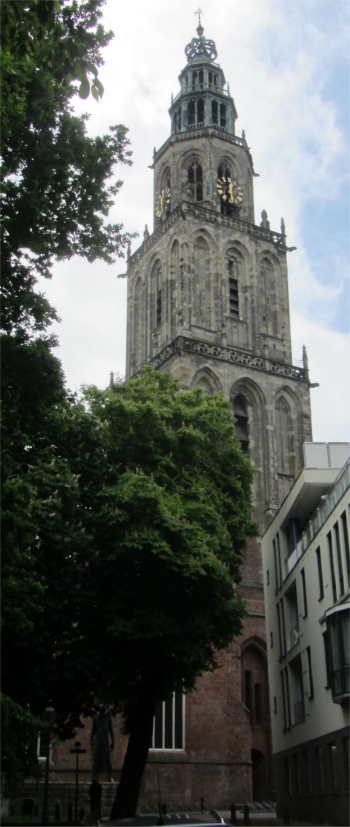
Martini Toren
|
Opposite this hospice was the Prinsenhoftuin (Garden). This delightful Renaissance style garden was laid out in 1625 and consisted of an herb garden with some old-Groningen fruit tree types, rose garden, covered hornbeam hedges and a box tree garden showing the initials of the vice-regent, Wilhem Trederik and his wife Albertine Agnes. Rex and Meryl were in raptures about this little oasis. To me, gardens are gardens, as obscure a turn of phrase as "It is what it is."
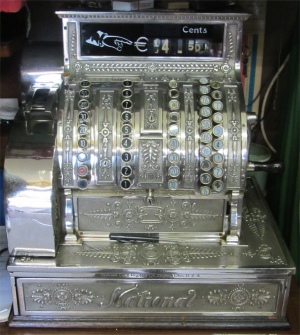
Cash Register
|
Heading back to the city centre, we strolled by a large green outside the Provinciehuis, where a bride and groom sat on a park bench while a photographer rolled about on the grass taking snaps from all manner of angles. That can't have done his suit any good. At the top end of the green, the provincial war monument of Saint George and the Dragon stood on the northern side of the Martini Kerk. This church originated from a wooden church which, through the centuries has developed into the current 15th century Gothic hall church. In the Middle Ages, pilgrims came to this church to see the relic, the arm of John the Baptist.
Beside the church stood the Martini Toren (Martini Tower). The 97m high, 15th century Martini tower is Groningen's pride. Groningen inhabitants also lovingly refer to it as the "d'Olle Grieze" (Old Grey) due to the colour of the weather-beaten Bentheimer sandstone. Both tower and church were named after Saint Martin, the city's patron saint.
We now strolled back into the Grotemarkt. At one end stood the City Hall, a Neoclassic building dating from 1810. At the right-hand side of the building a bust stood of Rabenhaupt, the general who successfully defended Groningen against the bishop of Munster and his army in 1672.
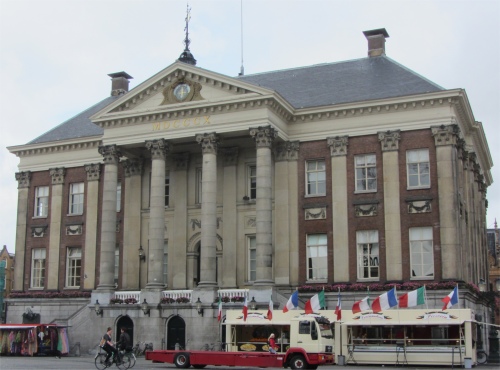
City Hall
|
We had completed the tour, and it had given us a good all-round view and flavour of the city and its history. It is said that two thirds of the transport modes used in the city are by cycle, and I could well believe it. Wherever we walked, cyclists seemed to rule, whizzing and weaving in all directions, somehow managing to never collide. Perhaps they had a sixth "radar" sense. I did observe a car invade a cyclist's space slightly on a crossing, and a torrent of abuse (my Dutch is not fluent, but there was no mistaking the tirade) showered on the driver. Despite all cycles having bells, not one was heard, and no helmets were worn.
It was a busy, bustling city, and I would have loved to have wandered around the Vismarkt or Grotemarkt on market days.
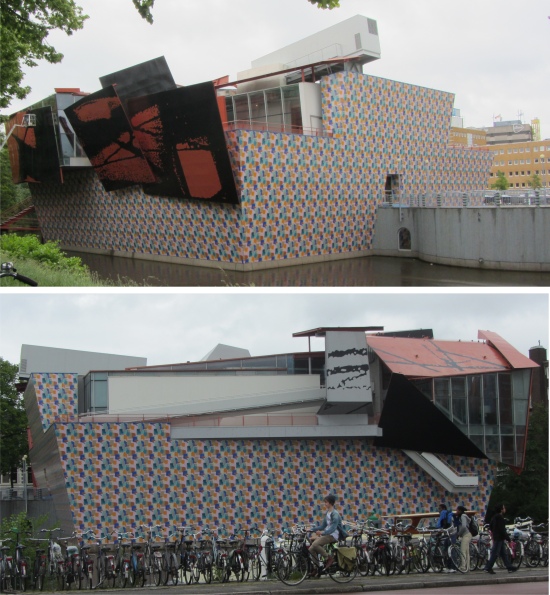
Groningen Museum
|
Feeling a little weary after our mammoth hike, we retired to the Three Sisters restaurant/bar, where Rex and I enjoyed traditional Dutch Uitmijters (fried eggs, bacon, mushrooms and cheese on bread), and Meryl just wanted to fall asleep. Suitably rejuvenated, we strolled down to the Groningen Museum. The town's main draw is set on its own island in the Verbindingskanaal, on the southern edge of the centre, directly across from the train station. Outside, the museum was of angular construction with bold orange and black surfaces, and other surfaces of dappled colours, almost pointillist. It was certainly not to Meryl's taste. Aside from a very cool information lounge with computers and touch screens, the museum is mostly given over to temporary exhibitions and what you see really depends on when you're here. If you're lucky, a rare work by the seventeenth-century Dutch painter Carel Fabritius - Man in a Helmet (probably the museum's most prized possession) - will be on display, or Rubens' energetic Adoration of the Magi and Isaac Israëls' inviting Hoedenwinkel from a modest sample of Hague School paintings.
Most people, however, visit as much for the building itself as for what's inside, which consists of six pavilions, each designed in a highly individual style: think Gaudí on holiday in Miami, and you'll have some idea of the interior decor. Once inside, between the stylish café and museum shop, the striking mosaic stairwell sweeps downwards, depositing you among bulbous lemon-yellow pillars and pink walls, from where moat-level corridors head off to pavilions either side: east to Mendini, Mendini 1 and Coop Himmelb(l)au, west to Starck and De Ploeg and the Starck Pavilion.
The temporary exhibition on display today was titled "FO2", featuring works by Chinese artists, whose works also served to make political statements against the oppression in their country over recent years. I always have a troubled mind when viewing conceptual art (am I being conned?), and there was plenty of it here.
Once we'd had our culture fix, we did a food shop in the Corn Exchange. Meryl had plans for prawns in garlic sauce, with salad for our evening meal. Hmmm, delicious. Rex had difficulty with this, an issue about Hollandaise sauce instead which I could not grasp. Nor could Meryl for that matter. I sidled over to the bread counter while they sorted out their differences in one of the aisles. Blows were not exchanged, nor were the words, "Nelson never had this trouble." Tempers were eased with a cool beer before we caught our bus back to Lauwersoog.
We had a splendid meal on board in the evening, and I disgraced myself at winning a few card games.
